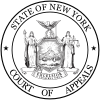That Portion of the Cayuga Indians Residing in Canada v. State
| That Portion of the Cayuga Indians Residing in Canada v. State | |
|---|---|
 |
|
| Court | New York Court of Appeals |
| Full case name | That Portion of the Cayuga Indians Residing in Canada v. State |
| Argued | April 20 1885 |
| Decided | June 2 1885 |
| Citation(s) | 99 N.Y. (54 Sickels) 235, 1 N.E. 770 |
| Holding | |
| The Canadian Cayugas have no standing to sue under a treaty between New York state and the Cayuga nation | |
| Court membership | |
| Chief Judge | William C. Ruger |
| Associate Judges | Charles Andrews, George F. Danforth, Robert Earl, Francis Miles Finch, Theodore Miller, and Charles A. Rapallo |
| Case opinions | |
| Majority | Danforth, joined by unanimous (Finch concurred only in the result) |
That Portion of the Cayuga Indians Residing in Canada v. State, 1 N.E. 770 (N.Y. 1885), was an early litigation of aboriginal title in New York, with the Canadian Cayugas seeking to recovery compensation from a prior land cession.
The Cayugas ceded 1,536,000 acres to the state in 1789 and 1795. The 30-mile-wide strip ran from Lake Ontario to Pennsylvania. In 1789, following the cession, many of the Cayugas relocated to Canada. In 1795, another group relocated to Ohio.
The Canadian Cayugas, led by chief O-ja-gegh-ti, sought to recover, plus 72 years of interest, a portion of a $2,300 perpetual annuity that New York had only been paying to Cayugas residing in New York and Ohio, pursuant to a 1796 treaty written on deerskin—or two treaties dated 1789 and 1795, or two treaties dated 1790 and 1795—and reaffired in the 1814 Treaty of Ghent (which ended the War of 1812).
The Canadian Cayugas had not received payments since 1809, by 1884, and sought total compensation of $83,000 or $100,000, and by 1885, $400,000 or $500,000.
The Board of Land Commissioners reported to the state legislature in 1849, recommending that the claim be paid. The legislature took no action.
The claim was filed before the "board of audit" in February 1883, and later transferred to the Board of Claims by statute.
The claim was heard by the Board of Claims on December 6, 1883. The hearing was presided over by Commissioner Lyman H. Northup, joined by George M. Beebe, and Henry F. Allen. The state was represented by Deputy Attorney General James A. Dennison.
The state moved to dismiss, and the Board did not rule on the motion before closing its session on December 8.
Canadian Cayuga Isaac Davis visited the United States Commissioner, James C. Strong (who, in private practice, would later litigate Seneca Nation of Indians v. Christy), who was representing the Cayugas in connection with the claim, on May 4, 1884 to discuss the status of the still-pending claim. New York Attorney General Denis O'Brien had set the second hearing before the Board and himself for the following Tuesday, with Davis and Gen. Strong set to appear.
...
Wikipedia
